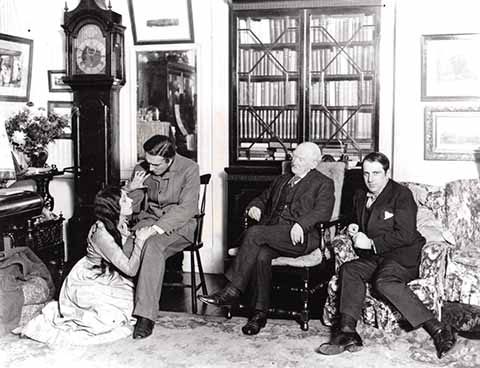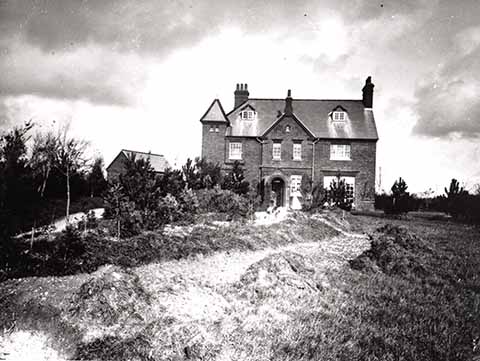The house that Hardy built
Roger Guttridge tells the story of Max Gate
Published in November ’18

Hardy with members of the Barnes Theatre Company who performed their touring production of Tess at Max Gate in 1924
Credit: Dorset County Museum
It was 1883 and Thomas Hardy’s star was in the ascendant. At 43, he had already had nine novels published, most recently Two on a Tower. More were planned, but for a while the architect-turned-novelist’s creative juices were focused on a very different project. After living in five different houses in ten years – in London, Swanage, Yeovil, Sturminster Newton and Wimborne – he had returned to Dorchester with his wife.
‘In 1883 Hardy was living in Dorchester and about to start writing The Mayor of Casterbridge,’ Dr James Gibson, told me in 1993, when he was chairman of the Thomas Hardy Society. ‘He had also reached the stage where he thought he could build himself a new house. It happened that the Duchy of Cornwall had a plot of land for sale. He looked at it and it suited him extremely well. It was only a mile from Stinsford Church, which he regarded as the most hallowed spot in England, and two miles from the cottage he was born in. His parents were still alive and two miles was just the right distance, as his wife and mother didn’t get on all that well.’
Hardy designed the house and employed his brother, Henry, to build it. Work started in 1883 but progress was slow and it was 1885 before it was ready for Thomas and Emma to move in. They named the house after the nearby toll-gate on the Wareham Road, known as Mack’s Gate from the name of its last keeper, Henry Mack.
Max Gate stood on a very exposed site and to protect it from the wind, Hardy planted more than 2000 trees; after his death in 1928, his second wife, Florence, had them felled, as they made the house dark and gloomy.
As Hardy’s fame and income grew, he added various extra rooms, including servants’ quarters in the attic and a new kitchen, scullery and larder. The drawing room was extended by adding a matching turret on the east side. Two attic bedrooms were added later and used by Emma as a boudoir and bedroom.
Hardy spent his last 43 years at Max Gate, during which time he had his study in three different first-floor rooms. In the first he wrote The Woodlanders (1885-7), in the second Tess of the d’Urbervilles (1888-90) and Jude the Obscure (1892-4) and in the third The Dynasts and many of his 900 poems. After his death, Florence gave the third study and its furniture, fireplace and other contents to the Dorset County Museum, where it was reconstructed.
The list of visitors entertained at Max Gate included Robert Louis Stevenson, W B Yeats, Virginia Woolf, T E Lawrence, James Barrie, Edmund Gosse, E M Forster, Robert Graves, H G Wells and John Galsworthy, who had the dubious (but not unique) distinction of being bitten by Florence Hardy’s infamous terrier, Wessex. After Florence Hardy’s death in 1937, Max Gate’s remaining furniture and effects were auctioned and the empty house put on the market. Hardy’s sister, Kate, bought it and left it to the National Trust when she died in 1940. She also made it clear that she was doing so in order to help secure her illustrious brother’s birthplace in nearby Higher Bockhampton. The Trust took her wishes on board and managed to buy the birthplace in 1948. The rent from Max Gate helped to cover the outgoings.
Max Gate’s tenants welcomed bone fide Hardy scholars and literary societies but not the general public. That changed 25 years ago this month. In November 1993, I and other journalists were invited to Max Gate to hear the story of its early years and to learn that public access was soon to be increased, with the agreement of the new tenants, who were to arrive the following month. From March 1994, the public would be able to view both the drawing room – where the Hardy guests were entertained – and the garden on three afternoons a week.
The new tenants were Hardy enthusiasts Andrew and Marilyn Leah. They lived at Farnborough, Hampshire, and were on holiday in Bournemouth when they saw a National Trust advertisement in the Echo seeking tenants for Max Gate, by now a grade one listed building. ‘When we started to explore the idea, we never really thought that we would actually end up here,’ said Andrew.


